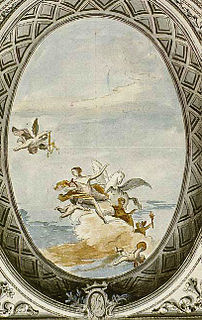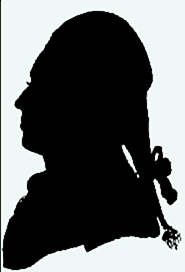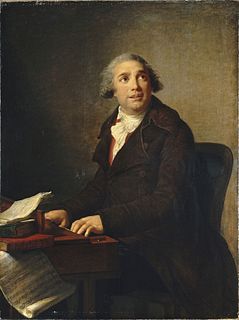
Anastasio Martín Ignacio Vicente Tadeo Francisco Pellegrin Martín y Soler was a Spanish composer of opera and ballet. Although relatively obscure now, in his own day he was compared favorably with his contemporary, Wolfgang Amadeus Mozart, as a composer of opera buffa. In his time he was called "Martini lo spagnuolo" ; in modern times, he has been called "the Valencian Mozart". He was known primarily for his melodious Italian comic operas and his work with Lorenzo Da Ponte in the late 18th century, as well as the melody from Una cosa rara quoted in the dining scene of Mozart's Don Giovanni.

Renato Fasano was an Italian conductor and musicologist particularly associated with 18th-century Italian works.

Il barbiere di Siviglia, ovvero La precauzione inutile is a comic opera by Giovanni Paisiello from a libretto by Giuseppe Petrosellini, even though his name is not identified on the score's title page.

The Accademia di Belle Arti di Venezia is a public tertiary academy of art in Venice, Italy.

La fiera di Venezia is a three-act opera buffa, described as a commedia per musica, by Antonio Salieri, set to an Italian libretto by Giovanni Gastone Boccherini.
A catalogue aria is a genre of opera aria in which the singer recounts a list of information that was popular in Italian comic opera in the latter half of the eighteenth and early nineteenth centuries. "Madamina, il catalogo è questo" from Wolfgang Amadeus Mozart's Don Giovanni is the most famous example, and is often referred to as "the catalogue aria". Leporello notes how many lovers the title character has had in each country he has visited. Pasquale sings two such arias in Joseph Haydn's Orlando paladino, "Ho viaggiato in Francia, in Spagna" in act one, which lists the countries to which he has traveled, and "Ecco spiano" in act 2, which rattles off all of his varied musical talents.
Carlo Francesco Pollarolo was an Italian composer, chiefly of operas. Born into a musical family, he became the cathedral organist of his home town of Brescia. In the 1680s he began composing operas for performance in nearby Venice. He wrote a total of 85 of them as well as 13 oratorios. His operatic style is noted for its development of arias accompanied by the orchestra and it shows some influence from the contemporary French opera of Jean-Baptiste Lully.

The Teatro San Moisè was a theatre and opera house in Venice, active from 1620 to 1818. It was in a prominent location near the Palazzo Giustinian and the church of San Moisè at the entrance to the Grand Canal.
Giovanni Battista Lorenzi (1721–1807) was an Italian librettist. He was born in Puglia and died in Naples and was a friend of Giovanni Paisiello, with whom he collaborated on numerous operas.
Antonio Palomba (20 December 1705 - 1769) was an Italian opera librettist, poet, harpsichordist, and music educator. He also worked as a notary. Born in Naples, he became a teacher of the harpsichord at the Teatro della Pace in 1749. Most of his more than 50 opera libretti were comedic works written for composers of the Neapolitan school. He also wrote some works for performance in Florence, Bologna and abroad. He died in Naples in 1769; one of the victims of a fever epidemic in the city. Many of his libretti were set more than once to music, and composers continued to use his libretti up into the 1830s.

Vincenzo Calvesi was an Italian operatic tenor and impresario. A skillful lyric tenor, he began his career performing in opera houses in Italy during the 1770s. He was active in Dresden in 1782 to 1783 and then spent most of his time performing in Vienna from 1785 to 1794. He is best remembered today for creating the role of Ferrando in the world premiere of Wolfgang Amadeus Mozart's Così fan tutte in 1790. That same year the Viennese publication Grundsätze zur Theaterkritik described him as "one of the best tenors from Italy…with a voice naturally sweet, pleasant and sonorous." He was later active in Rome as an impresario up until 1811.
La Passione di Gesù Cristo is the title of a libretto by Metastasio which was repeatedly set as an azione sacra or oratorio by many composers of the late baroque, Rococo and early classical period.
Joseph Mazzinghi (1765–1844) was a British composer.

Sylvie Mamy, born in Besançon, is a French writer and musicologist, docteur d'État ès-lettres, research director at the CNRS.

Teodoro Francesco Maria Gasparo Correr was a Venetian abbot and art collector, most notable as the founder of the Museo Correr.
I giuochi d'Agrigento is an opera by Giovanni Paisiello to a libretto by Count Alessandro Pepoli with which the rebuilt La Fenice in Venice was inaugurated on 16 May 1792. The castrato Gasparo Pacchierotti lead the cast. The plot is set against the games at ancient Agrigento on Sicily's southwest shore.












